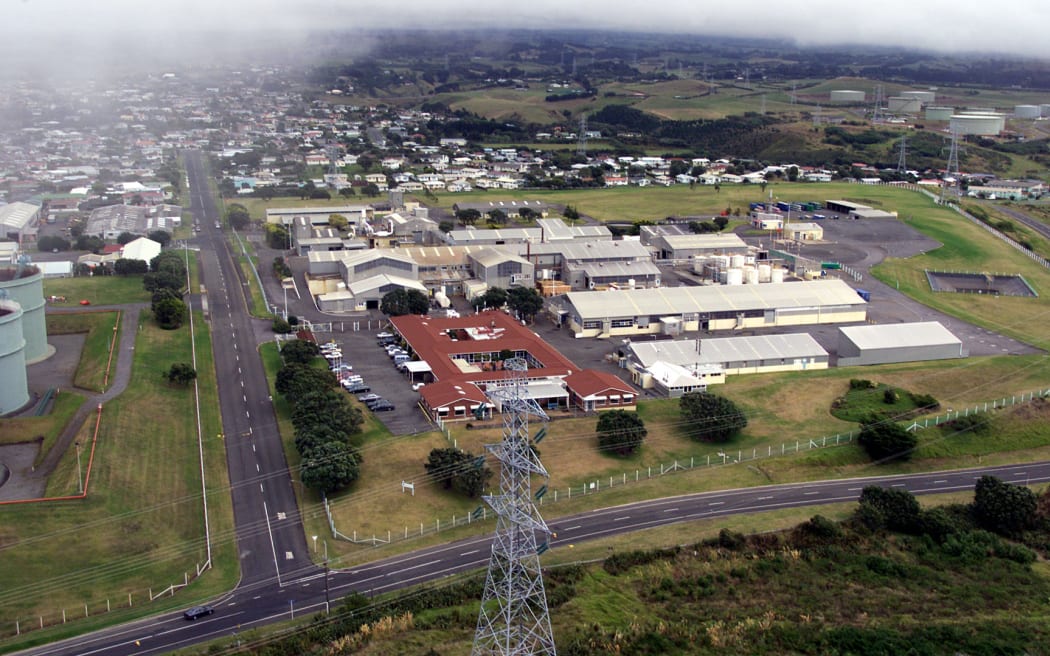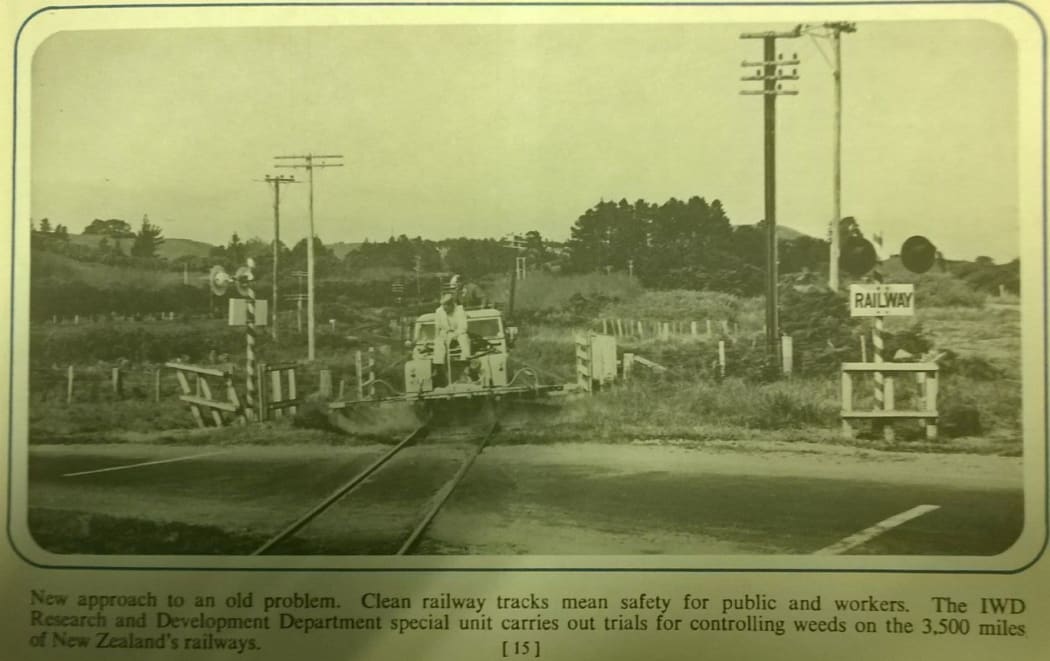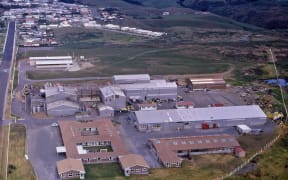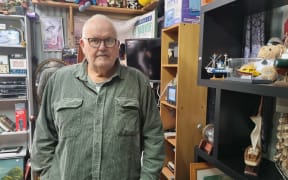
The DOW Agroscience plant in Paritūtū, New Plymouth pictured on 15 February, 2001. Photo: Getty Images / David Hallett
A former employee of a controversial chemical plant in New Plymouth wonders if the death of his first child from spina bifida was related to his time working there.
The multi-national company Dow is surveying anyone who was involved at its Paritūtū site, to fill in the picture of how chemicals there were used.
Graeme Platt had a student job at Ivon Watkins Dow (IWD) during the 1960s where he mixed chemicals in the lab and sprayed herbicides on test paddocks.
"There was never a time where I had any face protection or breathing protection or gloves or any other protection and, of course, when you're out working in the paddocks with sprays there was never an occasion or opportunity to wash your hands or anything before you ate your lunch."
From the 1960s through to 1987, Ivon Watkins (later Ivon Watkins-Dow) made the herbicide 2,4,5-T which contained the toxic dioxin TCDD, at Paritūtū.
The herbicide was a key component of Agent Orange - the defoliant used by the US military in the Vietnam War - which has been linked to cancers and birth defects.
Graeme Platt also sprayed the verges of the New Plymouth to Inglewood railway line with what he assumed was 2,4, 5-T.
Now a retired pharmacist, he never got a safety briefing while at IWD.
"No, no safety briefings because I don't believe safety briefings happened back in the 60s. I don't think face masks were a thing and I don't know if they realised the toxicity of what we were using."
About a decade later he had his first child.
"In 1974 it was and the baby was born with spina bifida and not expected to live, but she did actually for 15 months and then died.
"And of course we always wonder and my dad always wondered was there a connection, who knows?"
Platt said it was a very difficult time and he still thought about baby Juliette.
"I still wonder and I still don't know and no amount of research could definitely link it."
Platt, who went on to have two healthy children, did not blame Dow for Juliette's death.
He said the company operated to the health and safety standards of the day.

Graeme Platt helped spray the railway line between New Plymouth and Inglewood while working at IWD. Photo: Supplied
Malcolm Flett worked at a Hastings tannery in the 1970s and handled an array of chemicals.
One was a fungicide, Trinap 40, which he said was manufactured at IWD and contained Trichlorophenol a dioxin contaminated precursor for 2, 4, 5-T.
"During my time as a tanner I became quite unwell ... weight loss, migraine headaches and an inability to put on any sort of weight, so I weighed 42 kilos at 6ft tall."
A neurologist examined him.
"He went through the list of chemicals I was working with and his immediate reaction was 'oh, if I was you I'd never father any children because the genetic damage done by these chemicals will be severe'."
After a decades-long battle ACC recognised Flett had been poisoned, not by Trinap 40, but the solvent gluteraldehyde.
He never did have children.
"After 29 years when they finally came up with something they then said 'well there's nothing we can do for you, so just go away and die' which, of course, I refused to do, so that's fine."
Flett still harboured suspicions about Trinap 40.
Corteva Agricience took over Paritūtū as part of the DowDupont agro-chemicals merger in 2019.
It said it took employee and public safety very seriously.
It also said over several decades numerous governmental health reports, and one Dow-instigated University of Otago study of its employees, did not suggest the plant caused any adverse health impacts.
Dow took back control of the now decommissioned site earlier this year and was in the process of cleaning it up.
Te Whatu Ora reports
Te Whatu Ora's website holds two reports into the link between birth defects and Paritūtū.
The 2002 Neural Tube Defects At Westown Maternity Hospital, 1965-72, study was inconclusive. It said there was a higher number of defects in the Paritūtū area but it was not statistically significant and not possible to link them to the IWD plant at that time.
It recommended a review of the cluster following blood serum testing.
A 2010 Birth Defects Report prepared by Massey University's Centre for Public Health Research compared New Plymouth records between 1965-70 and wider Taranaki records between 1980-89 with the rest of the country.
It showed a high rate of birth defects in New Plymouth but not at levels substantially different from other parts of the country, noting some limitations in the available data.
The report said once dislocation of the hips and club feet were accounted for, the rate of birth defects was no different from anywhere else while observing these deformities were caused by physical pressure in the womb.
Rates of spina bifida - which had been linked to dioxin exposure - were little different between New Plymouth and the rest of country even during 1965-71 when the city's birth defect rates were highest, the report said.
It concluded the high rates of birth defects in the area were more likely to be due to local differences in clinical diagnosis, rather than any exposure to the Ivon Watkins Dow plant.
A later correction to the 2010 report pointed out that if congenitally displaced hips (CDH) were not included, the overall birth defect rate at the Westown Maternity Hospital in New Plymouth was significantly higher than National Women's Hospital as well as the rates reported at Queen Mary Hospital in Dunedin and in Northland.
Dioxin researcher Andrew Gibbs said that by reporting on Taranaki and New Plymouth the 2010 study used populations of around 100,000 and 40,000 which diluted the 1960s impact on Paritūtū.
"The Taranaki District Health Board's 2002 Neural Tube Defects report recommended a review of the Paritūtū 1968-72 anencephaly cluster which was 11.5 times the expected New Zealand rate - instead the 2010 report investigated the rate of anencephaly in wider New Plymouth."
In 1977, the Department of Health said stillbirths were the most likely impact following maternal exposures to 2, 4, 5-T, but Gibbs said the Paritūtū cluster of female stillbirths and any associated defects were not reported.
He said the 2010 report claimed high rates of birth defects were due to over-reporting of congenitally displaced hips (CDH), however the report's author was informed by the district health board in 2002 that CDH was not included in the 1965-70 Westown Maternity Hospital data.
"That aside the sharp rise in defects in 1970 at the same time as the spike in Paritutu stillbirths cannot be explained by the over reporting of CDH and club foot," said Gibbs.
Te Whatu Ora was unable to comment the impacts of Trinap 40, despite its link to 2, 4, 5, T, as this did not fall within scope of the Paritūtū dioxin study conducted by ESR.
It urged anyone who suspected they may have been affected by this chemical to seek advice from a health professional.
According to its website, NZ Veterans Affairs pays an ex-gratia payment of $30,000 to natural-born children of veterans who served in Vietnam between 1964 and 1972.
To be eligible people need to have been diagnosed with either:
- acute myeloid leukaemia
- adrenal gland cancer
- cleft lip
- cleft palate
- spina bifida.
If a child passes away from any of the conditions specified their immediate family may be able to claim an ex gratia payment of $30,000.




